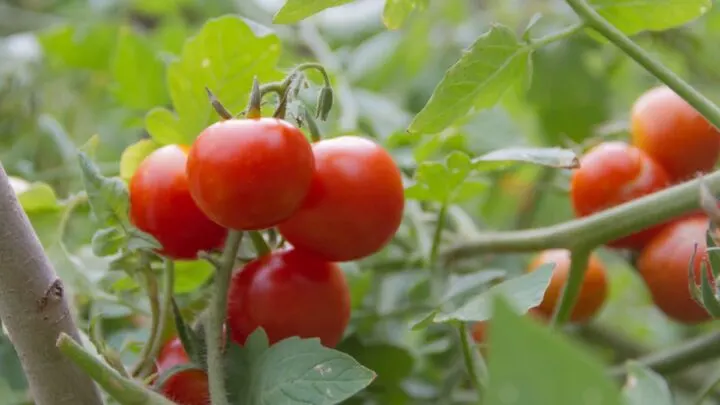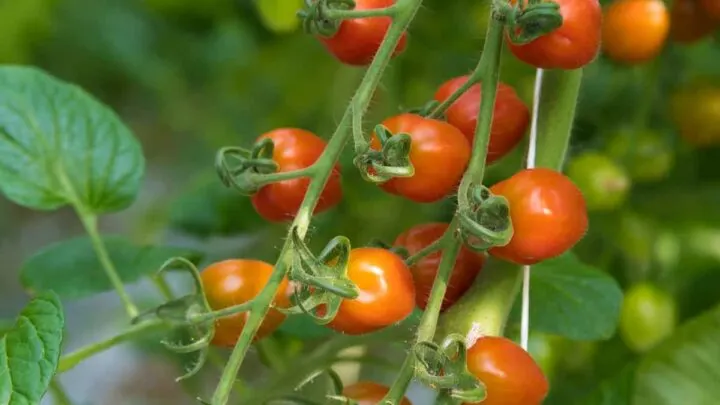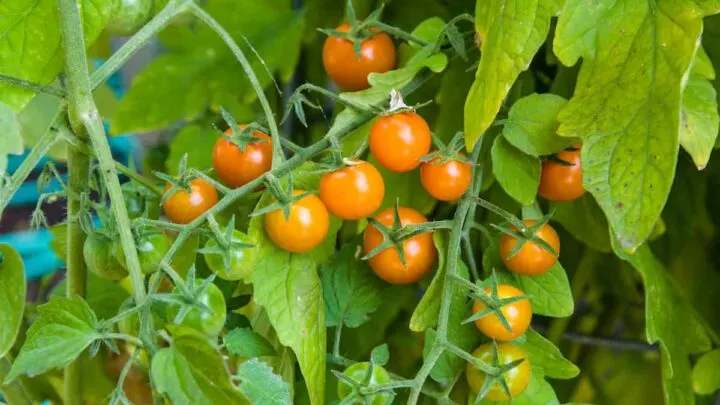When it comes to growing tomatoes, cherry tomatoes have always been said to be the most straightforward variety to grow. They are tolerant to many diseases, and the plant is the perfect size for easy care. Exactly how big do cherry tomato plants get?
Every cherry tomato plant can get anywhere from 4-8 feet tall. Environmental factors like sunlight, spacing, nutrients, and water can change that. Different varieties will all grow at different heights.
The article below contains everything you need to know about cherry tomatoes, how to care for them, the space they need, how they produce, and more! Stick around.

Determining How Much Space Cherry Tomato Plants Need
When it comes to growing tomato plants of any time, the space you grow them in matters. The same is true for cherry tomatoes. Although they produce tiny fruits, the root systems are still quite large, and the plant as a whole can get pretty big.
Indeterminate cherry tomatoes require at least 3 feet between each plant. You can plant determinate cherry tomatoes 2 feet apart. Each row needs to be around 18 inches apart.
Height Differences Between Indeterminate and Determinate Cherry Tomatoes
Tomatoes are broken down into many different varieties. However, they all fit into two categories: indeterminate and determinate.
Indeterminate
Tomato plants that grow longer. They usually are more viney and stretch out further than determinate tomatoes, thus needing more space. Indeterminate tomatoes will continue to produce fruit all season long and at staggered times.
Determinate
Determinate tomatoes grow to be much bushier and shorter. Once they hit their final height, they produce all their fruit at once, and once the fruit is harvested, it is for the plant.
How Many Cherry Tomato Plants Can Be Planted in a 5-Gallon Pot?
If you are planting indeterminate or determinate tomatoes, you should plant only one plant in a 5-gallon pot, so the plant has enough space to grow. If you have a 10-gallon pot, you can plant two determinate tomato plants. A 20-gallon pot may hold two indeterminate plants or up four determinate tomato plants.

Size By Growth Stage
There are many stages from the start to the end of a cherry tomato plant’s life. Each stage means different growth for the plant.
| Stage of Plant Life | Average Height |
| Germination | From seed to 3.5 inches |
| Seedling | 3.5 inches to 6-10 inches |
| Vegetative State | 6-10 inches to 48-60 inches |
| Flowering | 48-60 inches to 60-96 inches |
| Early Fruiting | Grows only a few inches (for example, 48 to 50 inches, 60 to 65 inches, 86 to 90 inches) |
| Maturity | 4 feet (48 inches) 8 feet (96 inches) |
The table above shows the different stages of a cherry tomato plant, and how much the plant grows in each stage.
You’ll notice that the cherry tomato plant grows the most during the vegetative state when the plant is taking in as much nitrogen as possible and trying to get as tall as possible before the plant starts producing fruit.
Once the plant starts producing fruit, the growth in height stops almost completely. The plant may stretch out a few inches, but most times, it will stop growing in height and send all its energy toward the growing fruit.
How many cherry tomatoes does a plant produce?
One of the wonderful things about growing cherry tomatoes is that they are known for having such a high yield!
Whether indeterminate or determinate, cherry tomatoes usually yield at least 150 tomatoes per plant or at least 8 pounds in one season. However, depending on the variety, they may produce much more or less–even up to 300 tomatoes per plant! I will show you some examples.
You’ll notice that the cherry tomato plant grows the most during the vegetative state when the plant is taking in as much nitrogen as possible and trying to get as tall as possible before the plant starts producing fruit.
Once the plant starts producing fruit, the growth in height stops almost completely. The plant may stretch out a few inches, but most times, it will stop growing in height and send all its energy toward the growing fruit.

How many cherry tomatoes does a plant produce?
One of the wonderful things about growing cherry tomatoes is that they are known for having such a high yield!
Whether indeterminate or determinate, cherry tomatoes usually yield at least 150 tomatoes per plant or at least 8 pounds in one season. However, depending on the variety, they may produce much more or less–even up to 300 tomatoes per plant! Notice the examples below.
| Variety of Cherry Tomato | Number of Tomatoes Produced in One Season |
| Baby Boomer- determinate | 8-15 pounds |
| Black Cherry- indeterminate | 8-15 pounds |
| Sungold- indeterminate | 8-12 pounds |
| Italian Ice- indeterminate | 8-10 pounds |
This table shows different varieties of cherry tomatoes and how many tomatoes each plant produces in one season.
As you can see, the average for all cherry tomato varieties is at least 8 pounds of tomatoes. Some may only produce 8 pounds, while others will produce up to 15 pounds.

Issues With Cherry Tomato Growth
If you see your cherry tomato plants getting stuck at 2 or 3 feet, they may be experiencing stunted growth. Stunted growth can happen for several reasons, as discussed below.
Water Habits
If plants do not get enough water or get too much, a common symptom is stunted growth. Cherry tomatoes, like all tomatoes, need 2 inches of water per week.
When a cherry tomato plant lacks water, not only is it missing out on a vital substance it needs to grow, but it also lacks the thing that helps transfer nutrients and oxygen through its roots.
If a cherry tomato plant gets too much water, its roots get too wet, and the plant begins to drown. When a plant has too much water, it stops nutrients and oxygen from flowing through the roots.
Nutrient Issues
Especially at the beginning of the plant’s life (during the seedling and vegetative stages), the cherry tomato plant needs the perfect amount of nutrients to grow up tall! Nitrogen is beneficial during these stages since nitrogen is what helps plants grow up tall and keeps them green and healthy.
Sunlight and Spacing Issues
Sunlight is another vital component of growing tomatoes, as is the proper amount of space for the cherry tomatoes to stretch their roots. To reach their growth potential, cherry tomatoes need 6-8 hours of sunlight daily.
In a question at the beginning of the article, we talked about the right amount of space for cherry tomatoes. They need between 2-3 feet of space between each plant to properly stretch their roots, which in the long run, helps them grow tall.
Diseases
If your cherry tomato plant has contracted a viral or fungal disease, this will most definitely cause stunted growth and may even end the plant’s life.
There are a handful of diseases that cherry tomatoes can contract, but luckily, cherry tomatoes are one of the most tolerant tomato plants. Below are a few diseases that cause stunted growth in cherry tomatoes.

Blight
Blight is a fungal disease that spreads quickly through spores carried by the wind or transferred through the soil. Early signs are browning on leaves, decay, stem decay, and wilting leaves.
Blight is a disease that you cannot cure. The only way to stop the spread is by removing the infected plants. You always want to be sure to throw the plants away or burn them. Never compost blight-infected plants; this will only further spread the disease.
Bacterial Wilt
Bacterial wilt is similar to blight, but it mainly lives in the roots of plants and is more commonly spread through the soil. Bacterial wilt is also incurable, and you should treat it how you would blight.
Tomato Root Rot
Root rot is also a fungal disease, but it is one of the few diseases you can cure. If you catch root rot quickly, you can transplant the plants into fresh soil, let the plants dry out, and hopefully, that stops the rot.
Root rot starts when soil is being overwatered and isn’t properly draining.
Tomato Spotted Wilt Virus
This disease is transferred by a very small bug called thrips. Spotted wilt virus is a viral disease that starts with small rings on the leaves or the plant’s fruit. Spotted wilt is also incurable and will kill your plants.
The best way to combat the spotted wilt virus is by quickly removing the thrips from your garden. You can do so with an insecticide or water your plants with a mixture of water and dish soap. Lay diatomaceous earth around your garden as a preventative measure.
How do I get my cherry tomato plant to produce more fruit?
If you feel that your cherry tomato plants aren’t producing as they should be, or you want to be sure your plants do end up producing more, you can follow these steps:
Lots of Nutrients
One of the best ways to ensure that your plants produce a good amount of fruit is to feed them nutrients.
While the cherry tomatoes are vegetative, feed them nitrogen once a week in a liquid feed with an NPK of 8-3-2 or similar.
Once the plants start flowering, you can ease back on the nitrogen and give them a higher dose of phosphorus and potassium. Once a week, give them a liquid feed with an NPK of 3-12-10 or similar.
Pinching Flowers
A common practice when growing tomatoes is to pinch the early flowers, which helps tell the plant to continue growing instead of starting to direct energy towards growing fruit. It will also help the plant produce more flowers once it reaches its full height.
Pruning
Lastly, another way to help cherry tomatoes produce more fruit is to prune the lower leaves. Using pruning shears, trim off the lower clusters of leaves and small branches, only about 5-8 inches up from the base of the plant.
Pruning will help the plant direct more energy toward the fruit and the branches that really matter at the top.
Final Thoughts
Cherry tomatoes, in my opinion, are a staple piece to any backyard garden. They are simple to grow, and they are perfectly delicious. Happy gardening!

Hi there, my name is Allie and welcome to my blog; GareningWithAllie!
Much of what you see written here is just our personal experiences with gardening. Along with the content I write here, there is also a unique collection of gardening topics covered by some of our close friends. I hope you find everything you read here to be helpful, informative, and something that can make your gardening journey the most lovely experience ever! With that said, Happy Gardening!
